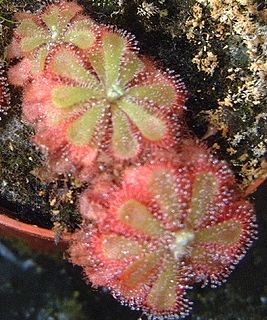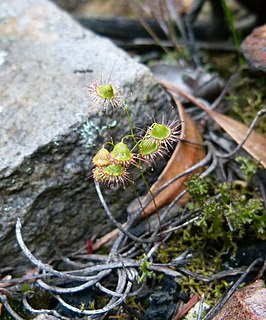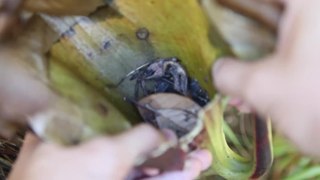
Drosera aliciae, the Alice sundew, is a carnivorous plant in the family Droseraceae. It is native to the Cape Provinces of South Africa, like Drosera capensis, the cape sundew, and is one of the most common sundews in cultivation. The plant forms small, tight rosettes of wedge-shaped leaves, up to 5 cm in diameter. Under conditions of good lighting, the insect-snagging tentacles will become deeply coloured with anthocyanin pigments, which probably aid in its attraction of insect prey. The plant is relatively easy to grow, and produces attractive scapes of pink flowers, which are held about 30 cm away from the carnivorous leaves, so as to prevent pollinators from becoming ensnared. D. aliciae is very similar in form to a number of other closely related species such as D. slackii, and D. dielsiana: the former is rather larger ; the latter rather smaller.

Sebastiania is a genus of flowering plants in the family Euphorbiaceae first described in 1821. It is native to North and South America from Arizona and the West Indies south to Uruguay.
Melocanna is a genus of Asian clumping bamboo in the grass family.

Drosera nidiformis is tropical African sundew. This plant is indigenous to KwaZulu-Natal in South Africa. Its classification is ambiguous; some sources refer to it as a synonym of Drosera dielsiana whereas others treat it as a separate species. This plant was previously known as Drosera "maglisburg".
Johannes Baptista von Albertini was a German botanist, mycologist and clergyman of the Moravian Church. He was born in the town of Neuwied.

Drosera dielsiana is a compact rosetted sundew native to South Africa, Eswatini (Swaziland), Mozambique, Malawi, and Zimbabwe. It was described as a new species by Arthur Wallis Exell and Jack Rodney Laundon in 1956. The chromosome number is 2n=40. It was named in honor of Ludwig Diels, the author of the 1906 monograph on the Droseraceae.

Drosera venusta is a subtropical sundew endemic to South Africa. It was described as a new species by Paul Debbert in 1987. Some have questioned its specific rank, noting its affinity to D. natalensis, while others have reduced it to a synonym of D. natalensis.

Drosera slackii is a subtropical sundew native to the Cape Provinces of South Africa. It forms rosettes that range from to two to four inches in diameter, and produces pink flowers. It is named after the British plantsman and author Adrian Slack (1933-2018).

Drosera sect. Erythrorhiza is a section of 14 species of tuberous species in the genus Drosera. It represents a natural group of all the rosetted tuberous Drosera. Most species are endemic to Western Australia, but D. aberrans, D. praefolia, D. schmutzii, and D. whittakeri are also found in eastern Australia.

Drosera bicolor is an erect perennial tuberous species in the genus Drosera that is endemic to Western Australia. It produces a basal rosette of leaves similar to that of D. peltata and the stem grows to 11 cm (4 in) high. Its white flowers that have a red spot near the petal base emerge from September to October. D. bicolor grows in deep silica sand on heathland along the upper Phillips River and south-east of Lake King.

Drosera heterophylla, the swamp rainbow, is an erect perennial tuberous species in the carnivorous plant genus Drosera that is endemic to Western Australia. It grows in shallow water swamps or wet clay flats near granite outcrops and occurs in the vicinity of Perth and to its north. D. heterophylla produces small leaves along an erect stem that can be 10–30 cm (4–12 in) tall. It is the only species in the genus that produces many-petaled flowers. These white flowers emerge from June to September.

Drosera huegelii, the bold sundew, is an erect perennial tuberous species in the carnivorous plant genus Drosera that is endemic to Western Australia. It grows in sandy soils in winter-wet depressions and margins of swamps and occurs along the south-west coast of Australia. D. huegelii produces small, bell-shaped leaves along an erect stem that can be 10–50 cm (4–20 in) tall. White to cream-coloured flowers emerge from June to September.

Alastair S. Robinson is a taxonomist and field botanist specialising in the carnivorous plant genus Nepenthes, for which he is regarded as a world authority. He is currently a manager at the National Herbarium of Victoria, Royal Botanic Gardens Melbourne, where he oversees identification botany services, the Library and Artwork components of the State Botanical Collection, and the botanical journal Muelleria, a peer-reviewed scientific journal on botany published by the Royal Botanic Gardens Victoria, for which he is Editor in Chief.

Albertinia is a genus of flowering plants in the daisy family described as a genus in 1820.

Drosera subg. Lasiocephala, sometimes collectively known as the petiolaris-complex, is a subgenus of 14 species in the genus Drosera. These species are distinguished by their subpeltate to peltate lamina.

Drosera lanata is a carnivorous plant in the genus Drosera and is endemic to the Northern Territory and Queensland in Australia. Its leaves are arranged in a compact basal rosette. Narrow linear petioles less than 2 mm wide emerge from the center of the rosette and hold carnivorous leaves at the end. Both petioles and the center of the rosette are densely covered in silvery dendritic hairs. These dendritic hairs afford the plant insulation and allow it to trap morning dew for additional moisture during the dry season. The leaf lamina is maroon-red and 2 mm long by 2.5 mm wide.
Drosera zeyheri is a species in the carnivorous plant genus Drosera that is endemic to the Cape Provinces of South Africa. Some botanists treat this species to be a form of D. cistiflora. It differs from typical D. cistiflora specimens by being smaller, sometimes having cauline leaves on the short stems with white, pink, or red flowers. Botanist Fernando Rivadavia has said that he believes of all the forms and varieties in the D. cistiflora complex, D. zeyheri could possibly merit distinction at the species rank. He found it easy to distinguish it from D. cistiflora by its mostly stemless habit, though it often does present one to three leaves on the flower scape. Drosera zeyheri was first described by Terence Macleane Salter in a 1940 volume of the Journal of South African Botany.

Kurt Polycarp Joachim Sprengel was a German botanist and physician who published an influential multivolume history of medicine, Versuch einer pragmatischen Geschichte der Arzneikunde and several other medical reference works.
Johann Heinrich Dierbach was a German pharmacist and botanist.

Schweiggeria is a genus of flowering plants in the violet family Violaceae, with one or two species, found in eastern Brazil.
















